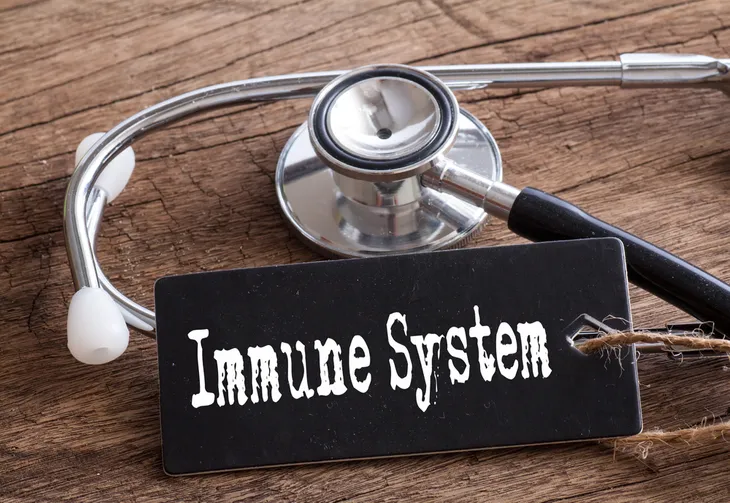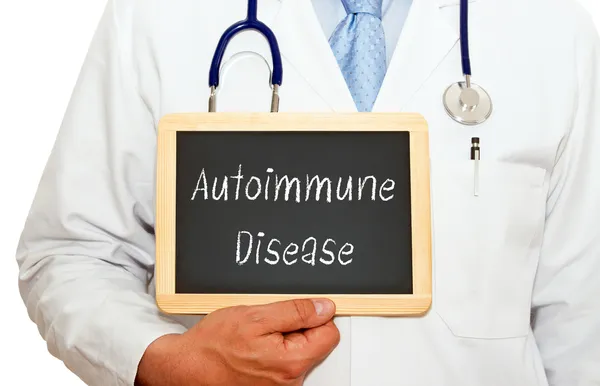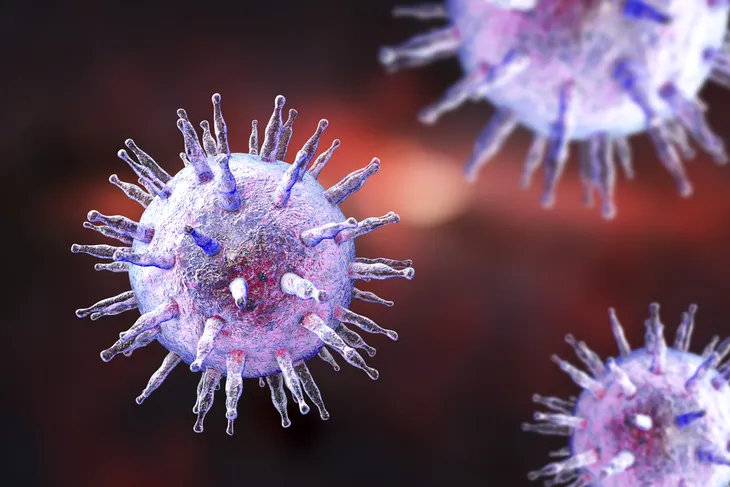Lymphoma is actually a cancer that starts in the cells that are meant to fight infections, which are located primarily in the lymph nodes and bone barrow, according to WebMD. “When you have lymphoma, lymphocytes change and grow out of control,” it explains.
There are actually two types of lymphoma: Hodgkin lymphoma (HL) and non-Hodgkin lymphoma (NHL), which involve different types of lymphocyte cells. However, here are 13 risk factors for lymphoma in general…
Weakened Immunity
The Canadian Cancer Society says having a compromised immune system can increase your risk for NHL. There are different ways this can happen; you may have a weakened immune system from birth, which is called congenital immune system damage, or it could develop over your lifetime, which is called acquired immune system damage.
However, “no matter when your immune system is damaged, it doesn’t change your risk for developing NHL,” it adds. Factors that can damage your immune system include human immunodeficiency virus (HIV), autoimmune disorders, and certain infections (such as hepatitis B and C).
Autoimmune Disorders
These conditions occur when your body’s defenses mistakenly attack healthy tissues of your body. Patients dealing with an autoimmune disorder may be taking an immunosuppressant drug, which can increase the risk for NHL, adds the Canadian Cancer Society.
Examples of autoimmune disorders that have been linked to NHL risk include Sjogren’s syndrome, which causes dry eyes and dry mouth, as well as rheumatoid arthritis, lupus, celiac disease, and Hashimoto’s thyroiditis.
Certain Infections
Both viral and bacterial infections can increase the risk of developing NHL, according to the Canadian Cancer Society. That’s because the infections may damage lymphocytes, “or constantly stimulate the immune system so it doesn’t work properly.”
Some infections that may increase the risk of NHL include Epstein-Barr virus, which can cause everything from a sore throat to muscle weakness. Other infections include Helicobacter pylori infections, which are linked to stomach ulcers, as well as hepatitis B and C, which both negatively impact the liver. Another bacterial infection called Campylobacter jejuni can cause gastrointestinal infections and is linked with a type of lymphoma called mucosa-associated lymphoid tissue (MALT).
Exposure to Radiation
VeryWellHealth.com says there are a couple of ways radiation can increase your risk of developing primarily NHL. One of them could be from radiation treatments related to past cancer treatment. Chemotherapy for other cancers can also increase the risk. Medical X-rays also use low doses of radiation.
Meanwhile, while a lot less likely to be in these situations, radiation exposure due to being in close proximity to a nuclear reactor meltdown or atomic weapons can also increase your risk of developing lymphoma, adds the source.
Lice Treatments
The Guardian UK explains that an over-the-counter insecticide called lindane, often used to treat lice and scabies, has also been linked to an increased risk for lymphoma. While the use of this chemical is restricted in the UK, the article still warns that people overseas could be exposed to lindane through imported foods.
The article notes the World Health Organization reviewed the pesticide and found it to be carcinogenic (cancer-causing), and warned that exposure to it could increase the risk of developing NHL by a whopping 60-percent.
Other Pesticides
Lindane is one pesticide linked to an increased risk for lymphoma, but there are others, according to the Canadian Cancer Society. One of the most popular types of pesticide, known as dichlorodiphenyltrichloroethane or simply DDT, may be associated with a higher risk for NHL.
Another chemical, Agent Orange, may also be responsible for some cases of lymphoma. However, “evidence has not been consistent, so further research is needed to help clarify the possible link between pesticides and cancer,” says the source. However, there was a recent ground-breaking case against Monsanto, who produces Agent Orange and DDT, regarding the popular weedkiller Roundup and its contribution to the development of lymphoma.
Family History
There may or may not be a hereditary link to lymphoma risk, according to Very Well Health. “While some patients with lymphoma claim to have family members also afflicted with the disease, there is no known evidence that lymphoma is hereditary,” explains the source.
However, it notes that conditions that compromise the immune system may be common among family members, and we’ve already outlined how a weakened immune system can open the door to lymphoma.
Trichloroethylene and Lymphoma
There’s a chemical solvent called trichloroethylene that may be linked to an increased risk for NHL. The Environmental Protection Agency (EPA) says most of this solvent used in the U.S. is released during “industrial degreasing operations,” and even short-term exposure can cause symptoms such as dizziness and headaches.
The source also explains that a review of epidemiological studies suggests trichloroethylene could be the culprit for a number of cancers, including those of the lymphatic system, as well as the kidneys, liver, and cervix.
Dietary Habits
The Canadian Cancer Society says researchers are still trying to establish a solid link between NHL and diet, but the society explains that studies have suggested eating a lot of meat and dairy products, as well as saturated fats, can increase your risk for lymphoma.
Meanwhile, other studies found an association between low consumption of vegetables and NHL risk. “The link between NHL and diet is very complex,” explains the source. It’s best to eat a balanced diet with lean meats, fruits, whole grains, and vegetables.
Being Overweight or Obese
Lymphoma Action in the UK says that some cancers are more prevalent among those who are obese, although a specific link to lymphoma has been suggested in some studies and not others. “It could be that the increased risk of lymphoma is due to poor diet and lack of exercise,” explains the source.
Meanwhile, the same source suggests maintaining a healthy lifestyle including a healthy weight, exercising regularly, and quitting smoking, can reduce your chance of developing health problems as a whole.
Hair Dyes
This may be a somewhat surprising risk factor for lymphoma, but according to Lymphoma Action, people that dyed their hair in the 1970s or earlier could be “slightly” more at risk than others for developing lymphoma due to the chemical content of the hair dye.
The source points out that newer hair dyes may be safer, but it “takes many years to find out.” Don’t sweat it too much, though, as the source notes the risk increase from using hair dyes and being exposed to certain other chemicals is likely small.
Your Occupation
The Canadian Cancer Society explains that a number of studies have drawn a line from certain occupations to increased lymphoma risk. The specific jobs include farming, forestry, printing, welding, and working in the rubber industry.
However, it adds that researchers haven’t identified the specific exposures that would explain an increase in lymphoma risk, and more research is needed.
Other Factors
While some of these risk factors mentioned are within your control, there are others that unfortunately are not. One of these risk factors is age. Very Well Health says, while both children and adults can develop lymphoma, it’s most commonly diagnosed among adults over the age of 60.
The source also says men are “slightly” more prone to developing lymphoma than women overall, although some forms of lymphoma strike women more often. It also explains that Caucasian people in the U.S. are more prone to this type of cancer than those of African-American or Asian descent living in the country.
















